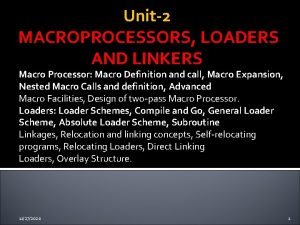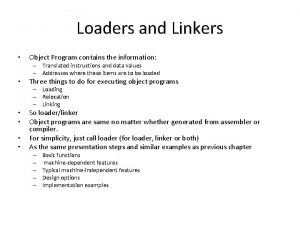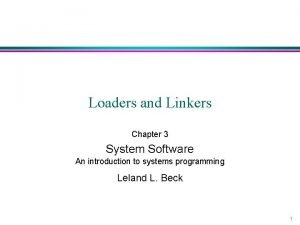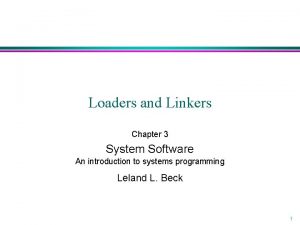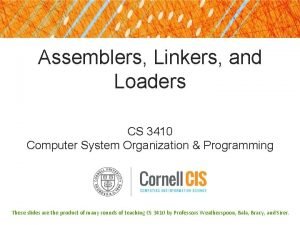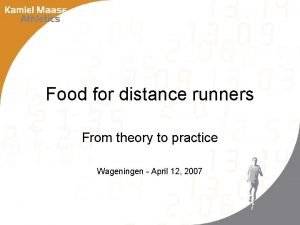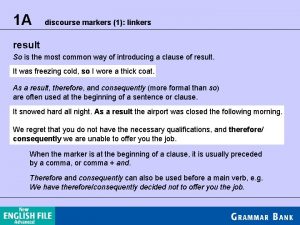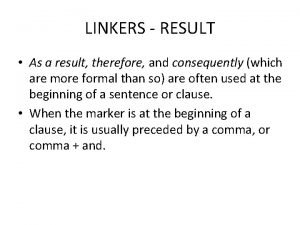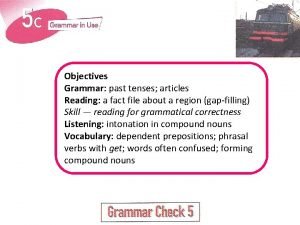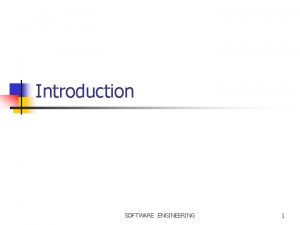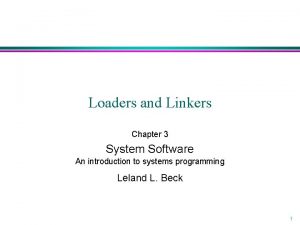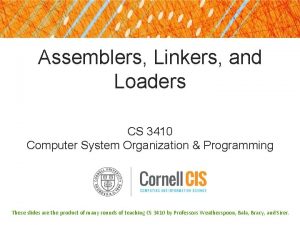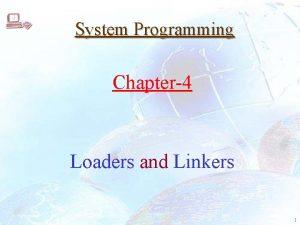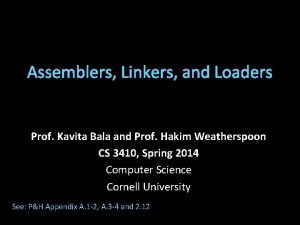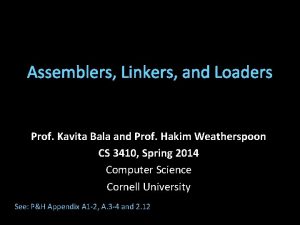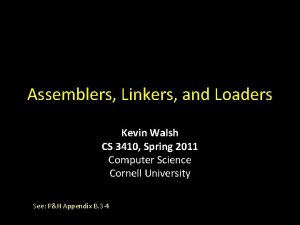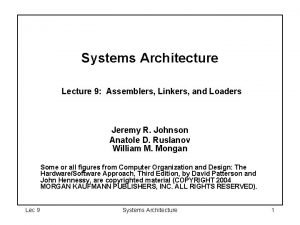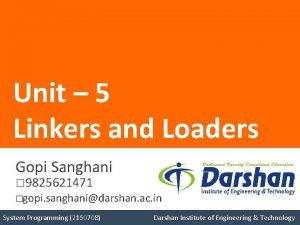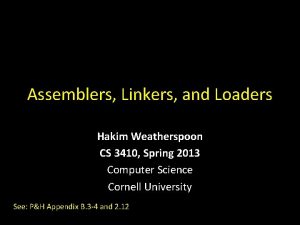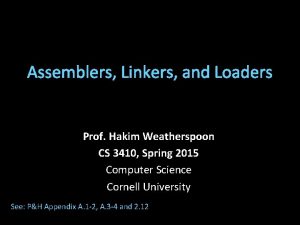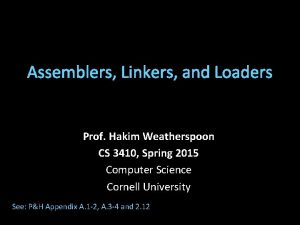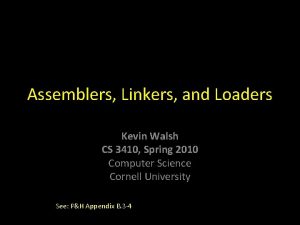Loaders and Linkers Chapter 3 System Software An
























- Slides: 24

Loaders and Linkers Chapter 3 System Software An introduction to systems programming Leland L. Beck 1

Introduction l To execute an object program, we needs » Relocation, which modifies the object program so that it can be loaded at an address different from the location originally specified » Linking, which combines two or more separate object programs and supplies the information needed to allow references between them » Loading and Allocation, which allocates memory location and brings the object program into memory for execution 2

Overview l assembler » generates an object code in a predefined format – COFF (common object file format) – ELF (executable and linking format) » assigns addresses to instructions and data – assuming the program starts at location 0 l loader » loads a program into memory(or AS) for execution » also performs relocation and linking l relocation » modifies the absolute addresses in the object program – assembler provides necessary information l linking » combines several object programs » these programs are developed independently » a program may use a symbol defined in another program 3

Bootstrap Loader l bootstrapping » actions taken when a computer is first powered on » the hardware logic reads a program from address 0 of ROM (Read Only Memory) – ROM is installed by the manufacturer – ROM contains bootstrapping program and some other routines that controls hardware (e. g. BIOS) l bootstrapping is a loader » loads OS from disk into memory and makes it run » the location of OS on disk (or floppy) usually starts at the first sector » starting address in memory is usually fixed to 0 – no need of relocation » this kind of loader is simple – no relocation – no linking – called “absolute loader” 4

Overview of Chapter 3 l Type of loaders » » l assemble-and-go loader absolute loader (bootstrap loader) relocating loader (relative loader) direct linking loader Design options » linkage editors » dynamic linking » bootstrap loaders 5

Assemble-and-go Loader l Characteristic » the object code is stored in memory after assembly » single JUMP instruction l Advantage » simple, developing environment l Disadvantage » whenever the assembly program is to be executed, it has to be assembled again » programs have to be coded in the same language 6

Design of an Absolute Loader l Absolute Program » Advantage – Simple and efficient » Disadvantage – the need for programmer to specify the actual address – difficult to use subroutine libraries l Program Logic 7

Fig. 3. 2 Algorithm for an absolute loader Begin read Header record verify program name and length read first Text record while record type is not ‘E’ do begin {if object code is in character form, convert into internal representation} move object code to specified location in memory read next object program record end jump to address specified in End record end 8

Object Code Representation l Figure 3. 1 (a) » each byte of assembled code is given using its hexadecimal representation in character form » easy to read by human beings l In general » each byte of object code is stored as a single byte » most machine store object programs in a binary form » we must be sure that our file and device conventions do not cause some of the program bytes to be interpreted as control characters 9

A Simple Bootstrap Loader l Bootstrap Loader » When a computer is first tuned on or restarted, a special type of absolute loader, called bootstrap loader is executed » This bootstrap loads the first program to be run by the computer -- usually an operating system l Example (SIC bootstrap loader) » The bootstrap itself begins at address 0 » It loads the OS starting address 0 x 80 » No header record or control information, the object code is consecutive bytes of memory 10

Fig. 3. 3 SIC Bootstrap Loader Logic Begin X=0 x 80 (the address of the next memory location to be loaded Loop A GETC (and convert it from the ASCII character code to the value of the hexadecimal digit) save the value in the high-order 4 bits of S A GETC combine the value to form one byte A (A+S) store the value (in A) to the address in register X X X+1 GETC A read one character End if A=0 x 04 then jump to 0 x 80 0~9 : 48 A~F : 65 if A<48 then GETC A A-48 (0 x 30) if A<10 then return A A-7 (48+7=55) return 11

Loaders that allow for program relocation are called relocating or relative loaders. Two methods for specifying relocation as part of the object program Modification records For a small number of relocations required when relative or immediate addressing modes are extensively used Relocation bits For a large number of relocations required when only direct addressing mode can be used in a machine with fixed instruction format (e. g. , the standard SIC machine) 12

Relocating Loaders l Motivation » efficient sharing of the machine with larger memory and when several independent programs are to be run together » support the use of subroutine libraries efficiently l Two methods for specifying relocation » modification record (Fig. 3. 4) » relocation bit (Fig. 3. 6 -3. 7) – each instruction is associated with one relocation bit – these relocation bits in a Text record is gathered into bit masks 13

Modification Record l l For complex machines Also called RLD specification » Relocation and Linkage Directory Modification record col 1: M col 2 -7: relocation address col 8 -9: length (halfbyte) col 10: flag (+/-) col 11 -17: segment name 14

Relocation Bit l l For simple machines Relocation bit » 0: no modification is necessary » 1: modification is needed l Text record col 1: T col 2 -7: starting address col 8 -9: length (byte) col 10 -12: relocation bits col 13 -72: object code Twelve-bit mask is used in each Text record » since each text record contains less than 12 words » unused words are set to 0 » any value that is to be modified during relocation must coincide with one of these 3 -byte segments – e. g. line 210 15

Program Linking l Goal » Resolve the problems with EXTREF and EXTDEF from different control sections l Linking l » 1. User, 2. Assembler, 3. Linking loader Example » Program and object code in Fig. 3. 8 -3. 9 » Use modification records for both relocation and linking – address constant – external reference 16

Program Linking Example 17

Program Linking Example l l Fig. 3. 10 Load address for control sections » PROGA » PROGB » PROGC l 004000 004063 0040 E 2 63 7 F 51 Load address for symbols » LISTA: PROGA+0040=4040 » LISTB: PROGB+0060=40 C 3 » LISTC: PROGC+0030=4112 l REF 4 in PROGA » ENDA-LISTA+LISTC=14+4112=4126 » T 0000540 F 000014 FFFFF 600003 F 000014 FFFFC 0 » M 00005406+LISTC 18

Program Logic and Data Structure l Two Passes Logic » Pass 1: assign addresses to all external symbols » Pass 2: perform the actual loading, relocation, and linking l ESTAB (external symbol table) 19

Pass 1 Program Logic l Pass 1: » assign addresses to all external symbols l Variables » » l PROGADDR (program load address) from OS CSADDR (control section address) CSLTH (control section length) ESTAB Fig. 3. 11(a) » Process Define Record 20

Pass 2 Program Logic l Pass 1: » perform the actual loading, relocation, and linking l Modification record » lookup the symbol in ESTAB l End record for a main program » transfer address l Fig. 3. 11(b) » Process Text record and Modification record 21

Improve Efficiency l Use local searching instead of multiple searches of ESTAB for the same symbol » assign a reference number to each external symbol » the reference number is used in Modification records l Implementation » 01: control section name » other: external reference symbols l Example » Fig. 3. 12 22

Figure 3. 12 PROGA PROGB PROGC 23

Linkage Editor (illustration) library object program(s) linking loader memory library linkage editor linked program relocating loader memory 24
 General loader scheme
General loader scheme Loaders and linkers
Loaders and linkers Loaders in system software
Loaders in system software Extref and extdef
Extref and extdef Assemblers and loaders
Assemblers and loaders Wise sunbathers football team
Wise sunbathers football team The theory and practice of lunch
The theory and practice of lunch Explain machine independent loader features
Explain machine independent loader features Markers and linkers
Markers and linkers Reason linkers
Reason linkers 3 condicional
3 condicional First conditional clauses
First conditional clauses Fce conditionals
Fce conditionals Linkers of addition examples
Linkers of addition examples Complete as sentenças usando os seguintes linkers
Complete as sentenças usando os seguintes linkers Linkers time
Linkers time Skills and applications chapter 3
Skills and applications chapter 3 Is an os system software or application software
Is an os system software or application software Open closed isolated system
Open closed isolated system Circularory system
Circularory system Generic and customized software product
Generic and customized software product Difference between student software and industrial software
Difference between student software and industrial software Examples of product metrics
Examples of product metrics Software maintenance process models ppt
Software maintenance process models ppt Who invented software engineering
Who invented software engineering
